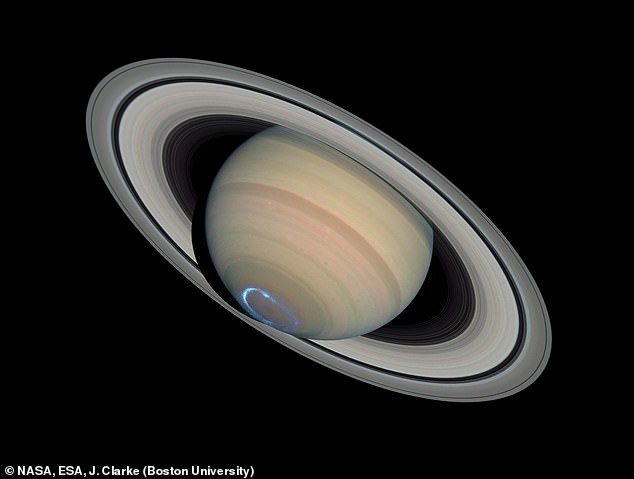Saturn’s rings will DISAPPEAR in 2025, NASA confirms
>
Time is running out to get one last look at Saturn’s rings, with only 18 months left before they disappear from view.
NASA confirmed that stargazers have until 2025 to see the distinctive structures before Saturn tilts toward Earth, turning the wide rings into an almost invisible line.
Saturn’s rings are enormous structures, extending from 43,500 to 87,000 miles (70,000 to 140,000 km) in some places.
However, it is very thin in comparison, measuring only 30 feet (10 m) in length at the main rings, making it disappear when viewed from the side.
However, the rings will not disappear forever, and will tilt back toward Earth during the next phase of Saturn’s 29-year orbit.
The next 18 months are the last chance to see Saturn’s rings before they disappear from view due to the planet’s tilt

During its 29-year orbit, Saturn tilts toward and away from the sun, giving Earth different views of its vast rings
Because of the inclination of its orbit, Saturn sways slightly toward and away from the Sun throughout its orbital period.
This means that for a short period, every 13.7 to 15.7 years, Earth sees the planet perfectly from the side.
At 746 million miles (1.2 billion kilometers) away, this makes the rings appear to disappear from our perspective.
Currently, Saturn’s rings are tilted downward toward Earth at an angle of 9 degrees, and by 2024 this angle will decrease to only 3.7 degrees.
The last time this rare astronomical event occurred was in September 2009, and before that it had not happened since February 1996.
Astronomers won’t get the chance to see Saturn from this unique perspective again until October 2038.

After 2025, stargazers will have a stunning view of the underside of Saturn’s rings, something that hasn’t been seen in more than a decade.
Earth’s passage through the visible edge may make Saturn’s rings impossible to see, but astronomers say it would be an excellent time to view some of the planet’s 156 moons.
After passing through the edge view, Saturn’s rings will quickly return to view as the planet’s south pole tilts toward Earth.
This will cause the bottom of the rings to appear in front of Earth, a sight that has not been visible for more than a decade and a half.
The rings will continue to appear more clearly until 2032 when Saturn reaches its maximum tilt away from Earth.
Saturn’s rings are mainly made up of chunks of ice, rock and dust trapped by the planet’s gravity.
While some particles are very small—no bigger than grains of sand—some chunks of ice can be as large as a house and some as large as mountains.
It is currently believed that the rings form from the remains of comets, asteroids and moons that were torn apart by Saturn’s strong gravity.
The exact time of its formation remains the subject of some debate among astronomers with competing theories suggesting it is as old as the solar system or relatively young.
While the disappearance of Saturn’s rings will only be temporary this time, scientists warn that the rings may one day disappear forever.
NASA’s Cassini probe, which flew through Saturn’s rings 22 times before diving into the planet in 2017, found that the rings were disappearing at a “worst-case scenario rate.”

Saturn’s rings are mainly composed of ice, rocks, and dust, which consists of the remains of comets and moons trapped by the planet’s intense gravity.
Cassini found that the rings lose between 880 pounds (400 kg) and 6,000 pounds (2,800 kg) of mass every second
“We’re still trying to figure out exactly how fast it’s eroding,” said Dr. James O’Donoghue, a planetary scientist at the Japan Aerospace Exploration Agency.
In a phenomenon known as “ring rain,” the sun’s radiation causes particles in the atmosphere to gain an electrical charge.
This, in turn, causes the molecules to bind to the gas in Saturn’s atmosphere, and they are pulled from the rings by the planet’s gravity.
Dr O’Donoghue added: “At the moment, research suggests that the rings will only be part of Saturn for another few hundred million years.”
(Tags for translation)dailymail
